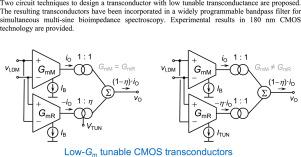用于同时多正弦生物阻抗谱的低gm可调谐CMOS传感器
IF 2.5
3区 工程技术
Q3 COMPUTER SCIENCE, HARDWARE & ARCHITECTURE
引用次数: 0
摘要
生物阻抗谱允许通过其电响应来确定介质的特性。在动态事件中,基于不同频率序列生物阻抗分析的方法由于其持续时间的限制而不适用。同时多重正弦谱法是快速获得生物阻抗谱的一种合适的方法。该技术的实际实现需要设计可编程滤波器,其中包括可调谐的晶体管,用于分离响应信号的不同频率成分。提出了两种设计可调谐跨导的电路技术。该解决方案的独创性依赖于两个电压-电流部分的Gm相减,从而不仅导致有效Gm的宽调谐范围,而且导致该电路参数的低值。采用180nm CMOS技术设计和制造了工作电压为1.8 V的晶体管。对9个硅原型样品的测量表明,尽管偏差在蒙特卡洛分析确定的变化范围内,但不匹配阻碍了模拟中获得的非常低的Gm。SF溶液和DP溶液的最大/最小Gm均值分别为10.29 μA/V/149.5 nA/V和10.1 μA/V/302.8 nA/V,跨导调谐比分别为68.8 x和33.4 x。该方案的另一个显著特点是,设计用于信号分离的二阶跨导体-电容(Gm-C)带通滤波器(bpf)包含了所提出的跨导体的多输出版本,从而减少了面积占用和功耗。bpf被设计为分别具有中心频率和质量因子0 dB和2.83的标称增益值,而中心频率可以在大约十年的时间内编程。本文章由计算机程序翻译,如有差异,请以英文原文为准。

Low-Gm tunable CMOS transconductors for simultaneous multi-sine bioimpedance spectroscopy
Bioimpedance spectroscopy allows determining the characteristics of a medium through its electrical response. In dynamic events, the approach based on sequential bioimpedance analyses at different frequencies is not appropriate due to its duration. Simultaneous multi-sine spectroscopy is a suitable alternative to obtain the bioimpedance spectrum in a fast way. The practical implementation of this technique requires the design of programmable filters, which include tunable transconductors, for the separation of the different frequency components of the response signal. Two circuit techniques to design a transconductor with tunable transconductance (), are proposed. The originality of the solution relies on the subtraction of the of two voltage-to-current sections, thus leading not only to a wide tuning range of the effective but also to a low value of this circuit parameter. The transconductors were designed and fabricated in 180 nm CMOS technology to operate with 1.8 V. Measurements on 9 samples of the silicon prototypes show that mismatch prevents achieving the very low obtained in simulations, even though the deviations are within the variation ranges determined by a Montecarlo analysis. The SF and DP solutions display mean values for the maximum/minimum of 10.29 A/V/149.5 nA/V and 10.1 A/V/302.8 nA/V, respectively, which represent transconductance tuning ratios of 68.8 and 33.4, also respectively. Other remarkable feature of this proposal is that the second-order transconductor-capacitor (-C) bandpass filters (BPFs), designed for signals separation, incorporate multiple-output versions of the proposed transconductors, thus leading to a reduction of area occupation and power consumption. The BPFs were designed to have nominal values of the gain at the centre frequency and of the quality factor of 0 dB and 2.83, respectively, whereas the centre frequency can be programmed over approximately one decade.
求助全文
通过发布文献求助,成功后即可免费获取论文全文。
去求助
来源期刊

Integration-The Vlsi Journal
工程技术-工程:电子与电气
CiteScore
3.80
自引率
5.30%
发文量
107
审稿时长
6 months
期刊介绍:
Integration''s aim is to cover every aspect of the VLSI area, with an emphasis on cross-fertilization between various fields of science, and the design, verification, test and applications of integrated circuits and systems, as well as closely related topics in process and device technologies. Individual issues will feature peer-reviewed tutorials and articles as well as reviews of recent publications. The intended coverage of the journal can be assessed by examining the following (non-exclusive) list of topics:
Specification methods and languages; Analog/Digital Integrated Circuits and Systems; VLSI architectures; Algorithms, methods and tools for modeling, simulation, synthesis and verification of integrated circuits and systems of any complexity; Embedded systems; High-level synthesis for VLSI systems; Logic synthesis and finite automata; Testing, design-for-test and test generation algorithms; Physical design; Formal verification; Algorithms implemented in VLSI systems; Systems engineering; Heterogeneous systems.
 求助内容:
求助内容: 应助结果提醒方式:
应助结果提醒方式:


